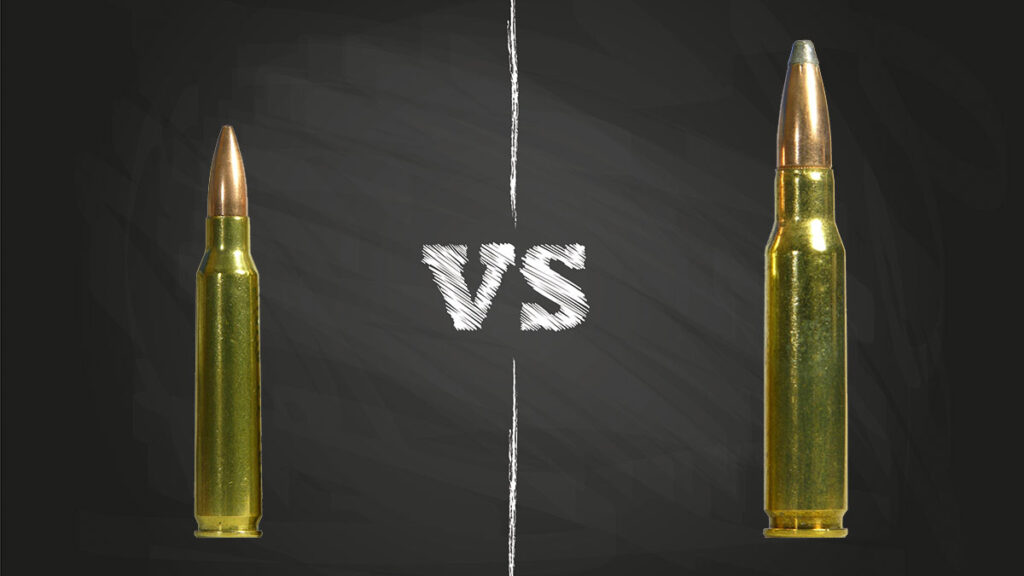
The great .223 vs .308 debate. I know this discussion is not new, but I having plenty of experience with both calibers through the military, law enforcement, and sporting purposes. This is my take on these two renowned calibers based on that experience.
The short version of this article is this: The .223 is best for small game. The .308 is best for large game.
A more detailed but still abbreviated version of this article can be found in the following chart with all of the substantive information that follows in the full article.
| Military Use | Defense | Sporting | Recoil | System Costs | System Weights | |
|---|---|---|---|---|---|---|
| Winner | Tie | .223 | Tie | .223 | .223 | .223 |
The M-14 Early Years
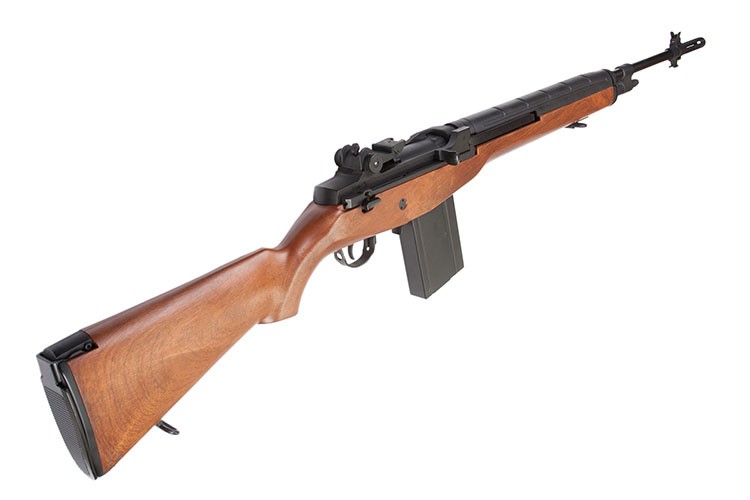
You know you’re no spring chicken if you went through Basic Training with an M-14. The embodiment of a full-size battle rifle, it fired 7.62x51mm NATO rounds better known in civilian circles as the .308 Winchester. The system’s authority was undisputed; however, one thing absent for trainees was any full-auto shooting.
The reason became apparent during several volcanic demonstrations. Effective “control” was conspicuously absent despite the best efforts of experienced cadre. This rifle was developed for a European war with the Soviet Union. That war never came and it slid into action in the early years of Vietnam. Still, we developed the upmost confidence in our M-14s and its capable .30-caliber cartridge – a shortened but still-worthy successor to the immortal .30/06.
The M-16 Early Years
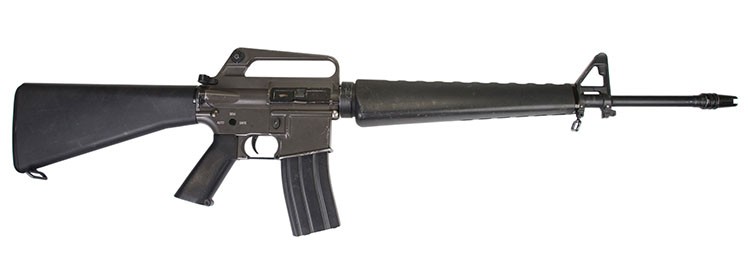
Several months later, the game changed. In a much warmer place, my group of replacement troops received radical new weapons. The aluminum and plastic M-16s felt more like toys and their pipsqueak 5.56 cartridges did little to ally these concerns.
Several of us were shooters and our first take upon viewing the new 5.56 round was “varmints!” Actually, that’s still a fair assessment. But, being green replacements, we had yet to grasp the 5.56 system’s weight-based advantages that translated to increased firepower.
Since then, more than a half-century has slipped by. Although I never would’ve expected at the time, I still regularly shoot both loads – actually three when factoring in the 5.56 NATO’s close civilian cousin, the .223 Remington. If nothing else, the passing years afforded opportunities to gain some hands-on military, law enforcement, and sporting experience with these calibers.
Cartridge Comparisons
Like other iconic cartridges (including the .30/06 Springfield), within relatively short periods, the 7.62x51mm NATO and 5.56x45mm NATO were offered to the U.S. sporting market. Today we recognize them in civilian form as the .308 Winchester, and the .223 Remington – sort of.
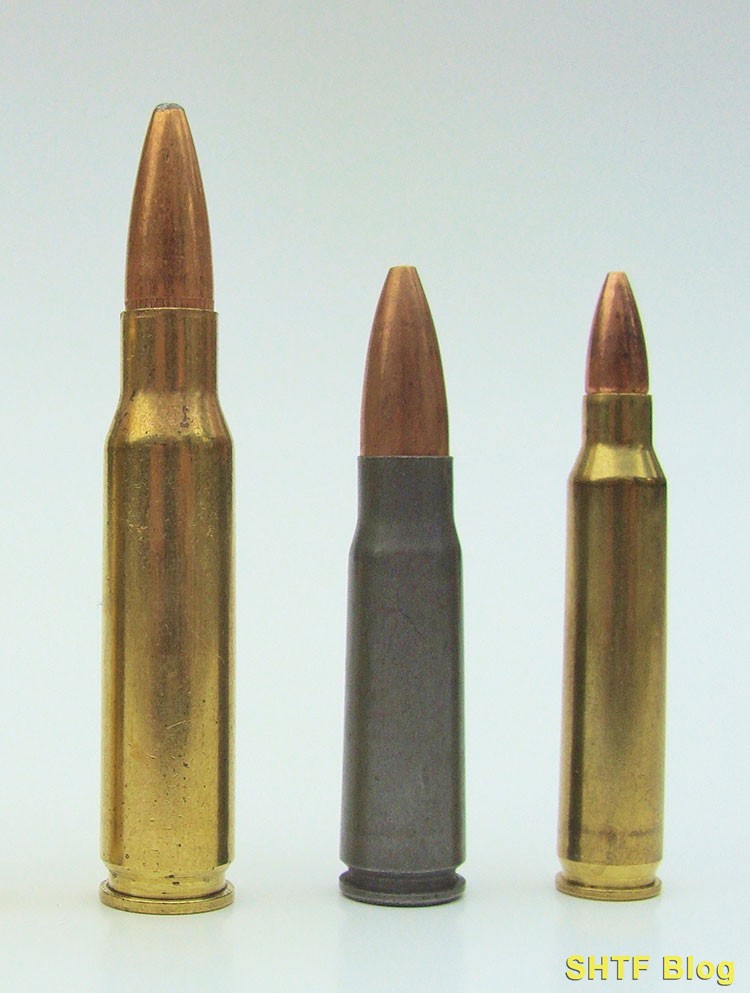
Across the board, many civilians refer to the 7.62 NATO as a “.308,” so from here on out, we’ll go with that. There are a few minor differences which may, or may not, be of concern.

But things differ with the 5.56 NATO – as they should. Dimensionally, the .223 Remington is identical. BUT, the current military version is loaded to higher pressures (see below). You can read more about this in the article on M193 vs M855 vs .223 ballistics.
5.56x45mm (and NATO)
The M-16’s success is closely intertwined with this small, high-velocity, centerfire .22-caliber cartridge. Velocity is greater than a .308, but bullet weight is much less. The result is a substantial reduction in recoil. This advantage is apparent during higher rates of fire where muzzle-climb becomes an issue.
The M-16’s (or AR-15’s) straight-line recoil impulse and pistol grip further mitigate this effect, resulting in greater hit percentages. The ammunition itself is also lighter, providing more rounds per pound.
Although today’s reference for military ammunition is 5.56x45mm NATO, that designation actually came much later than the original “5.56mm Ball, M-193”, which was adopted in 1963 for use with the M-16. The first version was just a militarized .223 Remington. Classified as M-193, it fired a 55-grain bullet at around 3250 fps from an M-16’s 20-inch barrel.
The bore was rifled with a 1:12 twist which is slow by today’s standards, but typical of other .22 centerfire varmint calibers from that era. Stories abound about nasty terminal effects related to tumbling bullets. Sometimes it happened – and sometimes, not.
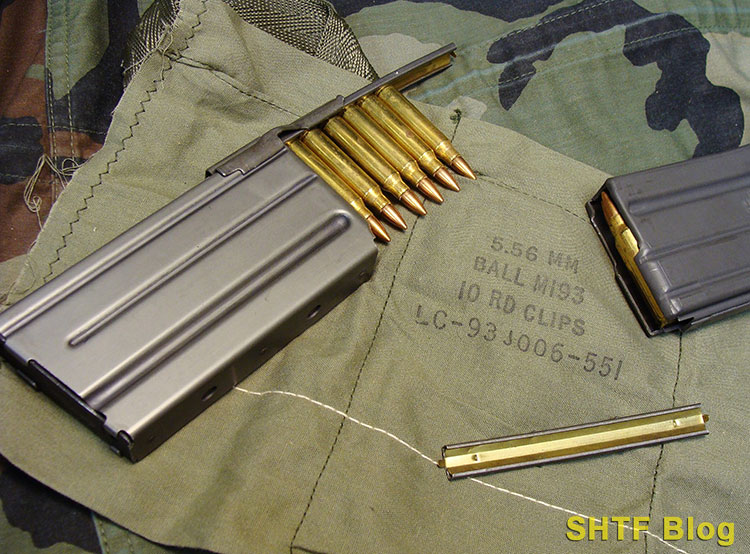
The 5.56x45mm NATO designation resulted from standardization efforts that included a boost to downrange penetration. One evolution known as M855 “Green-Tip” can met the standards by firing a heavier 62-grain bullet with a steel penetrating insert – when launched at 3025 fps. This performance was achieved via a 20-inch barrel and additional propellant, in conjunction with a modified chamber capable of controlling the higher pressure.
For this reason, you could get into trouble by firing 5.56 NATO in a .223 Remington chamber. One indicator of dangerous pressure is sticky bolt-lift during extraction, but reverse use of .223s in 5.56 NATO chambers is okay. The only real downside is possible degradation of top-flight .223 accuracy resulting from NATO chamber slop. One solution is the hybrid “Wylde Chamber”, designed to accommodate either load while improving the accuracy of .223s.
Both accuracy and penetration are affected by the barrel’s rifling. Adoption of heavier 5.56 NATO bullets required an increased twist-rate, so 1:7 became the new military standard.
.223 Remington
Unlike military U.S. loads, the .223 was marketed for civilian use, meaning it wasn’t hamstrung by non-expanding bullets. Inevitably, large-scale use of the M-16 lead to steady growth of the .223 Remington and a variety of good bullet. Today, there are numerous choices for defense, varmints, some larger game animals, and bullseyes.

But, with bullet weights now running from 35 to 90-grains (or more), rifling rates are increasingly important. Heavier or longer-for-caliber bullets generally need quicker spin. Fire a 70-grain .223 bullet through a 1:12 barrel and it may hit a 100-yard target sideways – somewhere. I own purpose-built .223s, rifled from 1:12 (for 40-50 grain varmint loads) to 1:8 (for heavier or longer copper bullets).
Our agency M-4 type AR-15s are stamped 5.56 NATO but we spec’d their 16-inch barrels with 1:9 rifling to handle a number of mission-specific loads, many of which are .223 versions.
Velocity note: For either caliber, barrel length has a significant effect on velocity. Short barrels, although handy, will sacrifice speed. In a given load the loss will be around 25-40 fps per inch.
.308 Winchester
Although envisioned as an offshoot of the old .300 Savage, as noted above, the .308 is based on a shortened ’06 case. It was developed for use in machineguns and the M-14 Rifle (a post-war evolution of the classic M-1 Garand).
Being especially suitable for semi and full-auto systems, the new .30-caliber T-65 cartridge soon gained favor among other Cold War allies, culminating in its 1954 designation of 7.62 NATO. But, Winchester recognized its sporting potential even earlier and introduced the new .308 Winchester to civilians in 1952.
Both cartridges are almost identical, but military chambers are cut with a bit of extra clearance (headspace) to promote reliable feeding in machineguns, etc. Military rounds may also have thicker brass – a greater concern for handloaders, particularly when converting 5.56 brass to .300 Blackout.
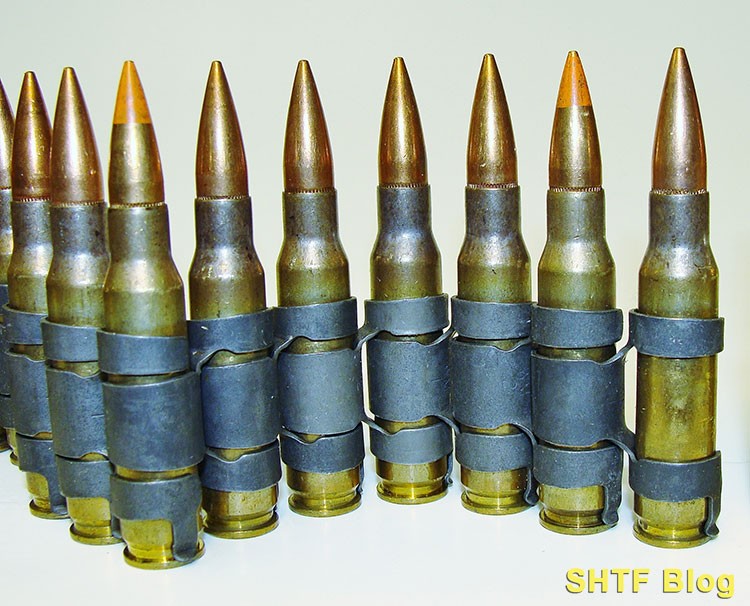
Nevertheless, I once fired a bunch of de-linked 7.62 machinegun rounds through my agency-issue Remington 26” HB M-700. Accuracy, although not sub-MOA, was good enough to ring steel silhouettes beyond a quarter-mile.
When finalized, the military T-65 fired a 147-grain bullet at around 2800 feet per second (fps), close to the ’06 thanks to more efficient propellants. Of course, heavier bullets and/or shorter barrels will decrease this velocity. The M-14 had a 22-inch barrel.
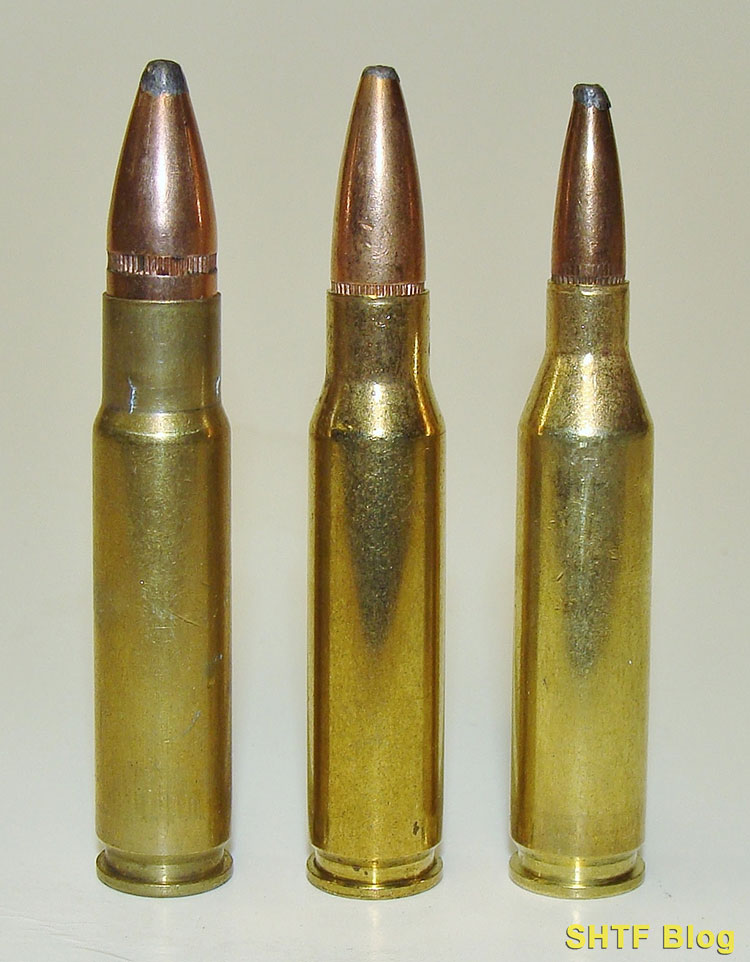
My chronograph indicates muzzle velocities closer to 2600 fps with several 168-grain loads fired through 20-inch barrels. The old ’06 will best most .308 loads (particularly those with heavier bullets), but the latter is still plenty capable. As a result of its popularity much effort has gone into civilian loads. To a lesser extent, the military also followed suit.
In a real sense, the .308 is a breakthrough cartridge. Its case was quickly reformed to create a series of other new calibers from .243 Winchester to .358 Winchester, along with several in between. Rifle manufacturers like Sako and Remington began offering “short-action” versions of their bolt-guns with compact receivers. These stiffer actions, if fitted with good barrels, can deliver outstanding accuracy.
The .308’s moderate propellant charges decrease recoil and also limit throat erosion. Most barrels incorporate 1:12 rifling which seems to stabilize a number of bullets weighing from 110- 180 grains. However, growing interest in long-range shooting has led to sleek but heavier projectiles of 190 grains or more. Thus, some barrels now use slightly quicker rates such as 1:10.
Which Caliber is Best?
Time for some hands-on comments. For better or worse, the following is based on personal experience dating to shortly after the Stone Age.
Military Use – Tie
I have no idea how many 7.62×51 and 5.56 rounds I either shot or saw fired during unhospitable circumstances, so I’ll just go with “lots.” For what it’s worth, I don’t recall anyone bemoaning the performance of the 7.62×51 (NATO). Admittedly, much of its use involved full-auto fire from aircraft or machineguns (the latter being a leg-squad’s life blood). Although relegated to FMJs, they produced decisive results.
The old 55-grain 5.56 load had less punch and fizzled out much sooner than 7.62×51 but was still up to the task within jungle distances. As for the M-16, it had been debugged by the time I carried one, and was controllable on full-auto. Quantity could offset punch but ammo consumption was a concern. More was always better – one weight-related advantage of this system in the bush.
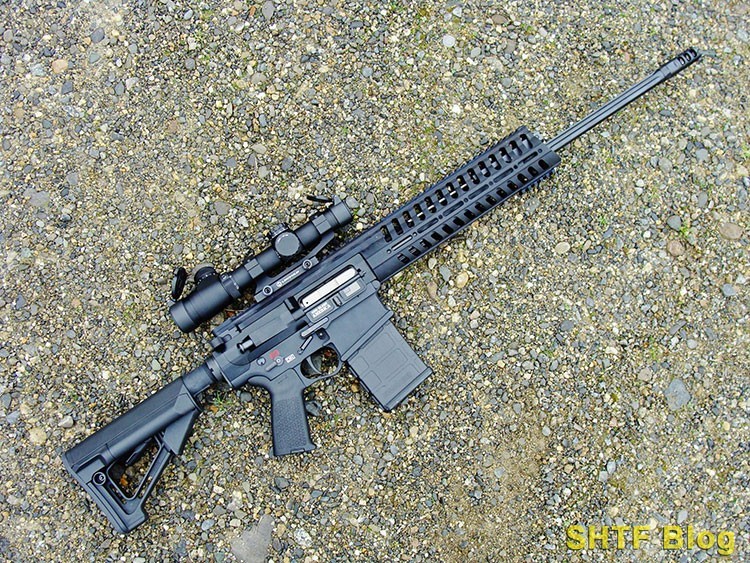
Funny thing though, ever since that era, seems like everyone and their uncle has been trying to make the 5.56 something it isn’t – like a more potent .308!
Yes, you can stuff the latter in an AR platform, but it won’t be the smaller version. Hence, much effort has gone into development of alternate AR-15 compatible calibers, some of which have real potential. That said, there have also been gains in the performance 5.56/.223 loads due to nonstop efforts.
Law Enforcement / Defense – .223 Wins
I had the opportunity to witness lots of shooting during my tenure as OIC of a government firearms training unit. Until the mid-1990s, a 12 gauge pump shotgun was the shoulder-fired weapon of choice. Today (partly due to hiring demographics),the firearm of choice is an AR15 chambered for 5.56/.223 Rem. Good choice, too! Just about any veteran within hiring age can already run one on demand.
For those who haven’t served, the manual-of arms is similar to most duty pistols, and recoil is negligible. We issue ‘em by the dozens, configured as 16” patrol carbines with Aimpoints, similar to military M4s. Much of their diet consists of .223 rounds which are purchased by the pallet-load. Of course, they run just fine.
However, we also back this system up with a small quantity of scoped .308 AR10s, reserved for use by designated marksmen. This detachment supports an even smaller coterie of true snipers, who are also equipped with .308s, precision bolt-guns. The .308 is by far the better barricade-busting choice, and is also less susceptible to atmospheric effects.
But, without a suppressor, it’s loud (for that matter, so is a .223)! Fire one shot indoors and you may wind up blind and deaf. Over-penetration is another real concern. From a training perspective, ammo cost is also much higher.
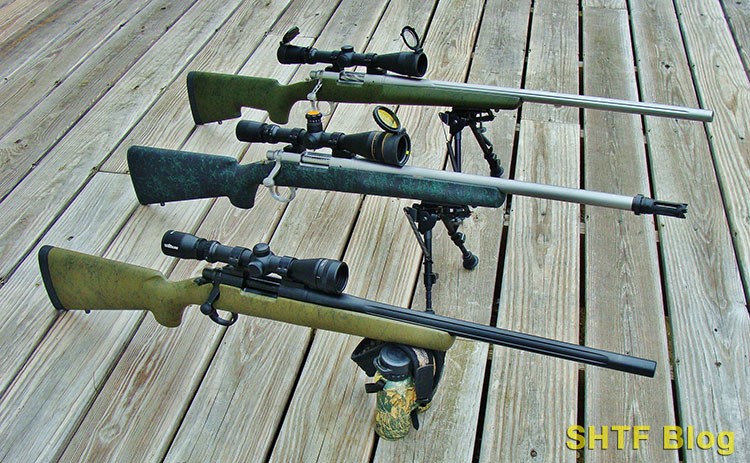
The same concerns may apply to civilians, particularly regarding home defense. Today, short-barrel rifles (SBRs) and AR Pistols are all the rage. They do have a place but, especially indoors, they’re hideously concussive unless suppressed. Assuming the choices boiled down to the above calibers, unless some long-range requirement existed, I’d opt for a 5.56/.223 AR-15; probably a 16” carbine with a good flash-hider and dot sight (or low-powered scope).
Of course, some preppers will thinking about a bug-out system. If so, weight will factor in (we’ll get to that).
Sporting Use – Tie
Varmints – .223 Wins
Before the .223 caught on, the .222 Remington was a top varmint choice, typically fired from heavy-barreled bolt-actions. Known for its exceptional accuracy, the “Triple Deuce” was actually the better cartridge based strictly on design, but it just couldn’t achieve the velocity of the .223 Rem. My one remnant Tikka 12 Ga./.222 combination gun is now rechambered to .223.
So far this post has had an AR15 slant, but for sporting use, I’ll often use a bolt-action. Either way, the .223 is no slouch in the accuracy department! It’s also a great varmint load, with lots of great bullet options. I’ve used the .223 on various critters from prairie dogs in the Dakotas to large Northern New England coyotes.
Firing light 40-grain bullets in a 26” Remington M-700 .223, velocity can approach 3800 fps – fast and great for prairie dog action! Bullets of 50 to 55-grains will work for all sorts of varmints. To gain some handiness, I often shoot them in shorter barreled bolt-guns and AR-15s.
But, our coyotes are actually grey wolf hybrids, some of which can weigh 50+ pounds. I’m not the only one in my area that considered a switch to a .243 after watching them vanish despite good hits. Turns out the .223 will work though. Like every other caliber, the key is the right bullet.
Hunting these tough critters at night while surrounded by dark fir thickets requires a load that’ll drop them in their tracks. I’ve had good luck with Federal’s 55-grain Ballistic Tips, fired from AR-15s. A second shot is seldom necessary, but it’s immediately available if needed. Federal’s 60-grain Nosler Partitions will also do the job and, in a pinch, I’d use them for deer. But, because or whitetails can run large, I’d much rather switch to a larger caliber.
Large Game – .308 Wins
The .308 Winchester fits this bill perfectly. The several people within my hunting circle have taken dozens of deer with it, mostly using bolt-actions. Remington’s pump-guns and autoloaders are used by many others, along with Browning BLRs. But, bolt-actions offer quiet loading in the predawn stillness of the woods, and they’ll work in any weather.
We’ve never found the .308 wanting, even if using basic 150 to 165-grains loads. So far, not a single deer has been lost to plain ‘ol Remington 150-grain Core-Lokts, or Hornady Interlock Spire Points of the same weight (handloaded, but also available as Hornady’s Whitetail ammunition). In my state the .308 has also taken its share of black bears and moose, sometimes with 180-grain loads. That’s the heaviest weight I’d care to shoot in this caliber – but there is another way to boost penetration.
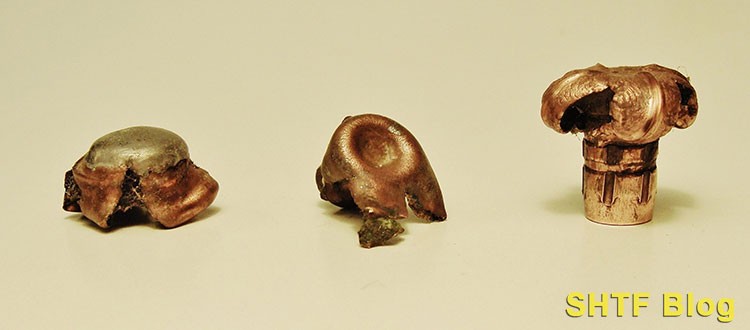
Recoil – .223 Wins
Anyone including kids should be able to manage the recoil of a .223 – even in a smaller rifle. The .308 is tolerable for many shooters, but it can still pack a wallop in lighter rifles. Gas-operated semiautos are usually softer shooters, but many are hefty.
One way to beat this conundrum is to use a lightweight bolt-action and go with “reduced-recoil” .308 loads. The several available versions provide power similar to a .30/30; entirely useful, but much easier on a shoulder. Any manually-operated repeater should feed them (or, see below).
System Costs – .223 Wins
Today, there are plenty of rifles to chose from in either caliber. Some of the more affordable bolt-actions shoot like gangbusters. For that matter, AR prices aren’t much higher, and most are surprisingly accurate. A decent optical aiming system is worthwhile and many good choices aren’t caliber specific. That leaves ammo.
Right now everything is hard to find. Mainstream choices help, but they still won’t be cheap. Practice makes perfect so, based on cost, the .223 has an advantage. But, of course, expense isn’t the only concern. After all, the “right choice” had better work.
System Weights – .223 Wins
Circling back to the M-16 for bug-out purposes, the entire system was light enough to provide more ammo in the bush. The usual load of 5.56 was around 300 rounds, although sometimes we’d carry 400, traveling with the barest essentials in our rucksacks. A similar quantity of .308 would’ve been tough, even without a heavier rifle. Of course, some of today’s newest AR-10s are lighter. Then again, many sporting bolt-action .308s weigh no more than .223s.
I broke out a scale for another article dedicated to this subject. One pound of 55-grain .223s worked out to 38 rounds. A switch to 150-grain .308s yielded only half as many; 19 rounds. Less weight is a Godsend for those who must travel on foot.
.223 vs .308 Closing Thoughts
If I was limited to three rifles, I’d choose a trio that could cover just about everything; a .22 LR, a .223, and a .308. Preferably, they’d incorporate similar function. As a believer of the KISS principle, they’d most likely be stainless/synthetic bolt-actions.
Why? Because my area is rural, so we don’t buy much meat – even when times are good.
But, what if circumstances called for only one rifle? Well, assuming both defense and subsistence hunting were requirements, geography might dictate the choice. If possible, I’d fudge it and go with a 5.56 AR-15, while slipping in a spare upper receiver chambered for .300 Blackout. We’ve killed a bunch of deer with .300 Blk using Barnes 110 and 120-grain solid-copper TAC-TX bullets.
Recoil is pretty much a non-issue. Swapping uppers is as easy as popping the receiver pins, and both calibers are widely distributed. Then again, our terrain is heavily forested. Ranges are short and our biggest carnivores are black bears.
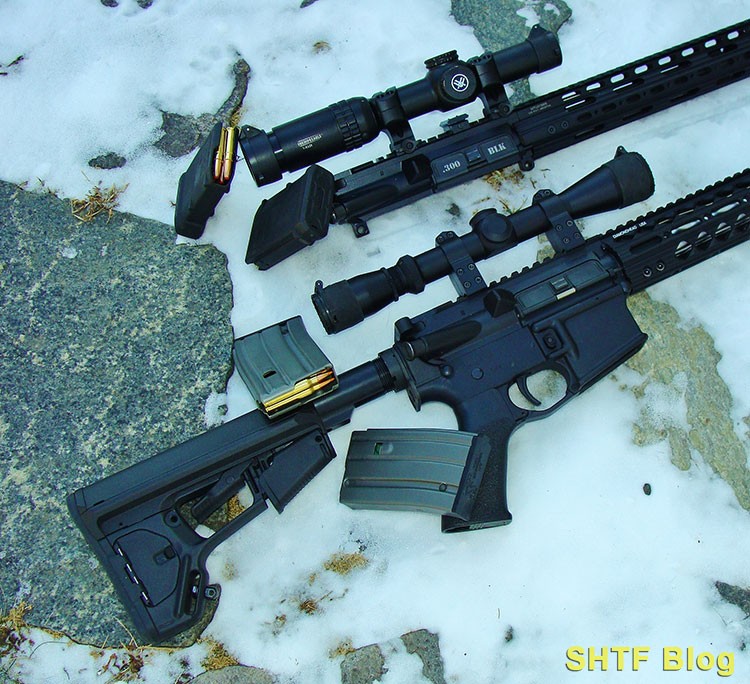
Western hunting is a different matter. Open terrain and large game call for more power and range, so the nod goes to a .308. If dangerous bears are a possibility, even that caliber is sketchy. Get a bigger gun or cross your fingers and spring for heavy monolithic loads.
In closing, I mentioned this topic to a trusted confidant. His reply? “Easy – .223s for varmints and defense, .308s for larger game.” Duh.

2 comments
Very well written by an obviously well experienced writer. Hat tip to you sir.
Thank you for the info!!!